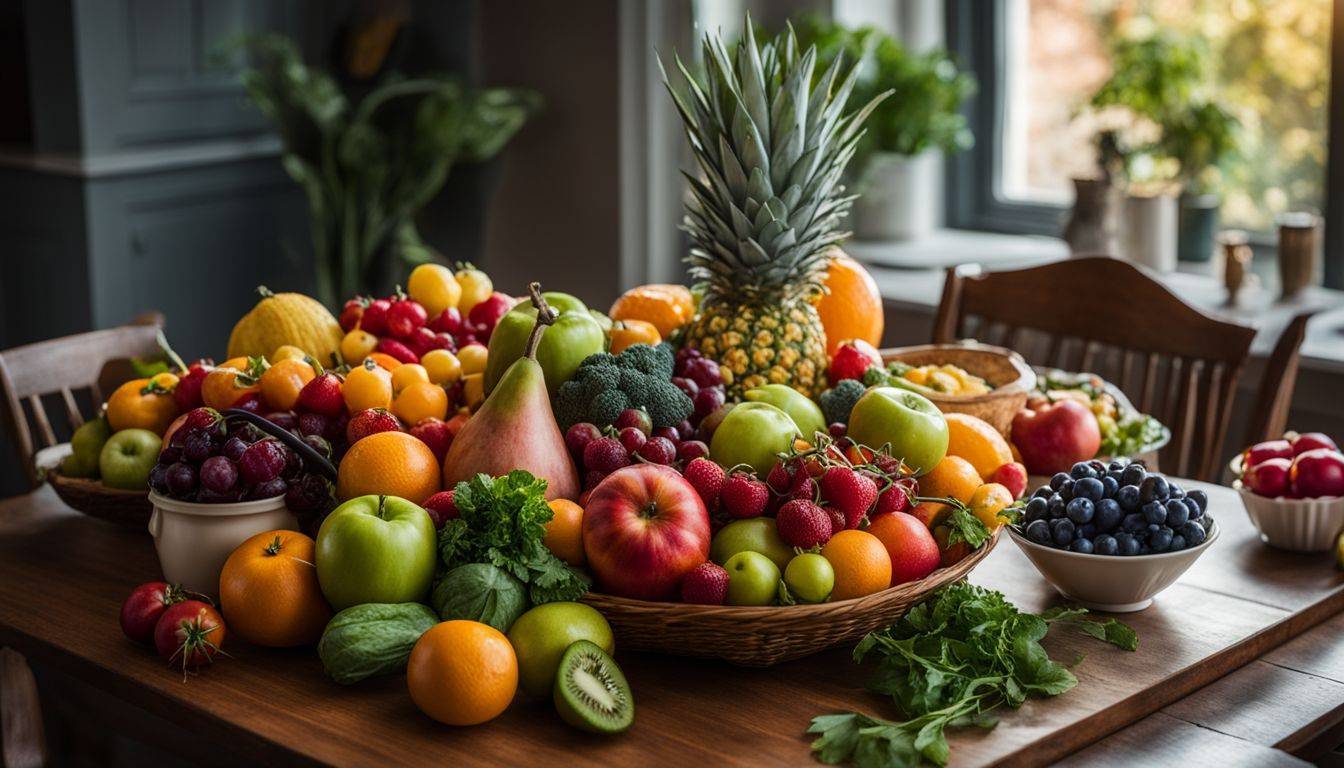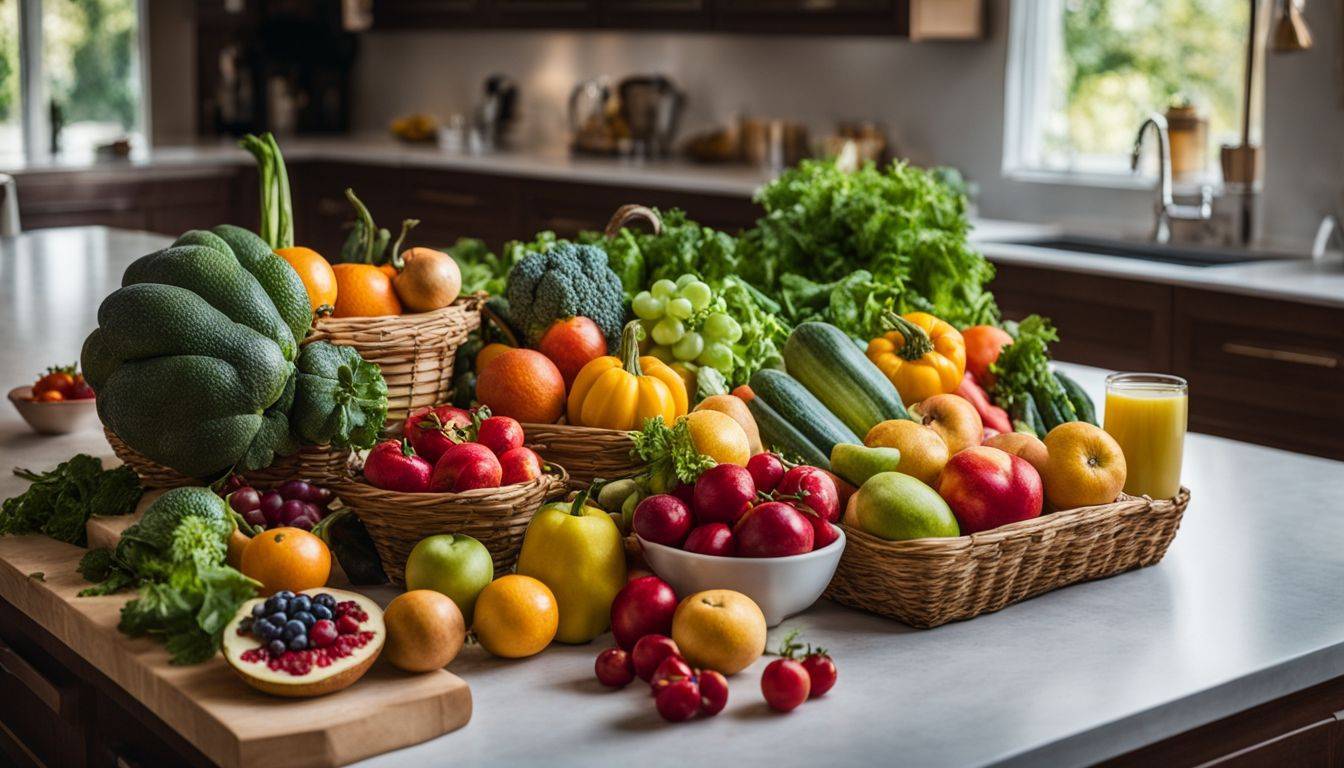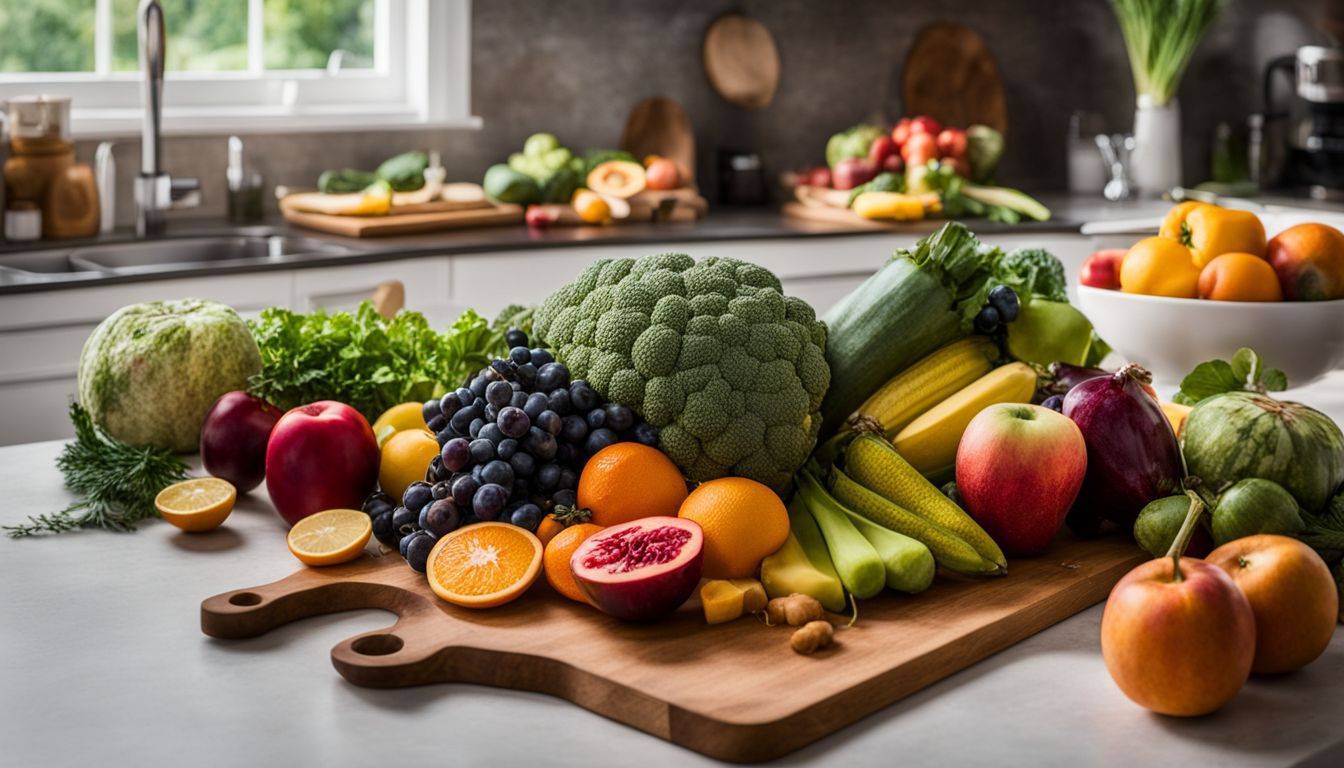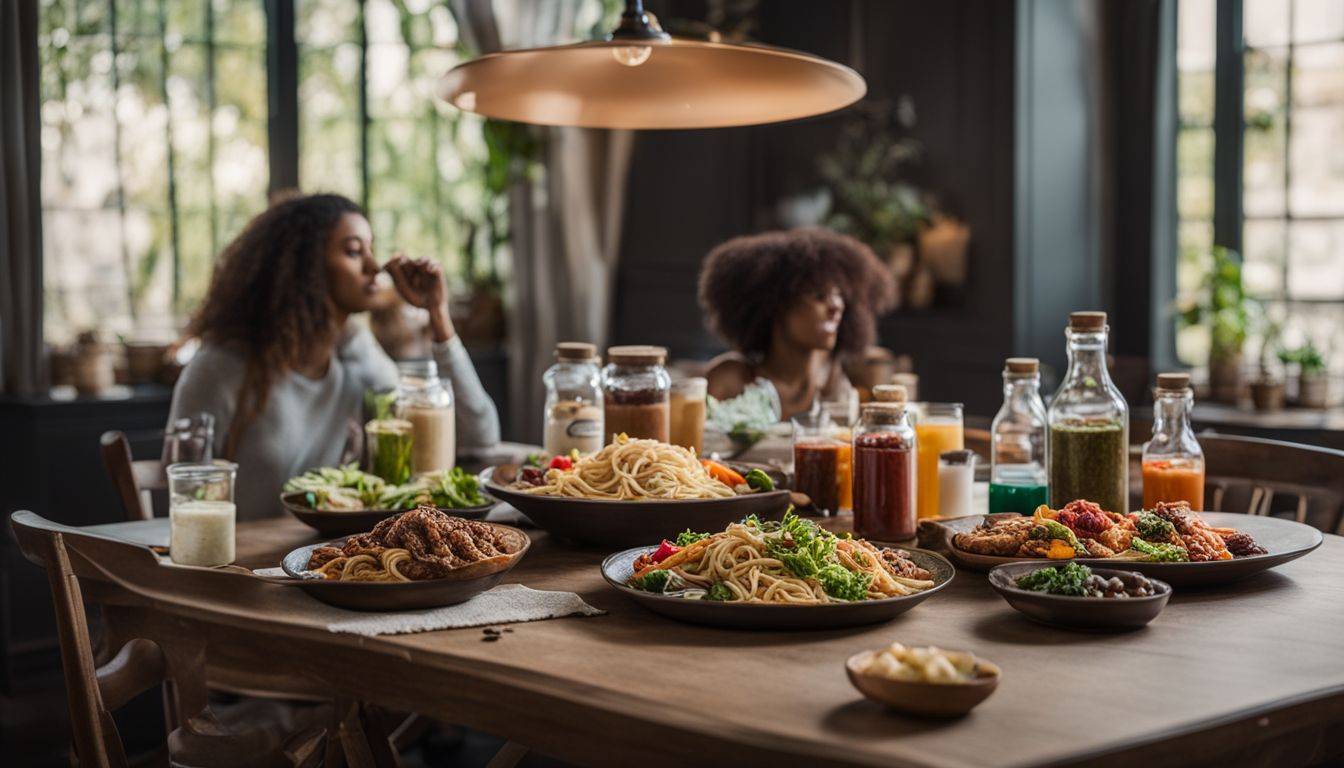Carb cycling is a way to eat that changes how many carbs you have each day. Some days, you eat more carbs, and other days, you eat fewer. This meal plan helps people who want about 2,000 calories every day without special food rules.
Eating the right kind of foods like whole grains and fruits with lots of fiber can make you feel good during carb cycling.
People choose carb cycling because it might help burn fat better, build muscles, lose weight, and control blood sugar levels. It can even make you do better in sports! But if not done right, this way of eating could cause sleep problems or other health issues.
During high-carb days on this plan, half your calories should come from carbs. Even on low-carb days, we still need some carbs for energy when we move our bodies a lot. So don’t go below 10-15% from carbs then. You may be in need of a carb cycling calculator for better fat loss and build muscle with this.
We need to stay away from bad foods like too much sugar or things made with many chemicals. Guys should not eat less than 1,500 calories per day and gals no less than 1,200 for staying healthy.
Remember that everyone’s body is different. You may need to talk with a doctor or use tools like calorie calculators to find what works best for you.
Now let’s get ready for seven days packed with smart eating!
Understanding Carb Cycling

2. Understanding Carb Cycling:.
Carb cycling is a strategic approach to dietary planning that alternates between high and low carbohydrate intake days, aiming to maximize the benefits of carbs for energy and fitness goals while managing overall calorie consumption.
It’s designed with the body’s metabolic processes in mind, leveraging periods of carb loading and restriction to influence weight management and muscle performance.
What is a Carb Cycling Diet?
A Carb Cycling Diet is a way to eat that changes how many carbs you have every day. Some days you eat more carbs, and other days you eat less. This kind of diet helps your body because it can improve your blood sugar levels and give you better energy for sports.
People like athletes or those who want to be stronger often use this diet.
Eating the right foods on this diet is key. You choose healthy things like fruits, veggies, whole grains, and proteins. On high-carb days, you eat more foods with good carbs in them.
On low-carb days, you cut back but still get to enjoy plenty of tasty meals that keep your body feeling good.
How Does Carb Cycling Work?
Carb cycling switches between days with more carbs and days with fewer. You eat high-carb foods to fill up on energy when you need it, like on workout days. Then, you cut back on carbs when your body doesn’t need as much fuel, which can help you burn fat.
This way of eating tries to match your body’s needs for energy from carbs with what you do each day.
Your muscles store extra carbs from high-carb days for times when they need quick energy. On low-carb days, your body uses the stored energy instead of getting it directly from food.
This may help keep blood sugar levels steady and support muscle growth while helping to lose weight. With a clever mix of higher carb and lower carb days, this plan helps avoid feeling tired or weak during workouts and daily activities.
Importance of Nutrition in Carb Cycling

Eating right is key to carb cycling. Your body needs good food like lean proteins, healthy fats, and complex carbs to work well. These foods help your body use energy better and support muscle growth.
On high-carb days, you eat more grains and fruits to give you quick energy for exercises like lifting weights or running. On low-carb days, you focus on foods with lots of protein and fat that help keep your hunger away longer.
Good nutrition helps manage how much sugar is in your blood. It makes sure you have enough nutrients for health and exercise without extra calories that turn into body fat. In carb cycling, eating the best foods can improve how sensitive your body is to insulin—a hormone important for controlling sugar levels in your blood—and help keep a steady amount of glycogen in your muscles so they’re ready when it’s time to move!
Health Benefits of Carb Cycling

Carb cycling isn’t just a strategic approach to eating; it yields tangible health benefits that align with various fitness and wellness goals. By alternating carbohydrate intake, individuals tap into their body’s metabolic flexibility, which can enhance fat burning processes and support muscle retention efforts.
Improved Fat Burning
Carb cycling helps your body burn fat better. It changes the way you eat carbs on different days to keep your metabolism high and energy up. This means on some days you eat more carbs, and on other days you eat less.
Your body gets good at using what it eats for energy instead of storing it as fat.
This eating plan can make losing weight easier because it works with how the body naturally burns fat. By switching between higher and lower carb days, your body has to adjust constantly, which keeps burning calories even when you’re not working out.
This could be a smart way for people who are overweight or want to get healthier to help their bodies get stronger and leaner.
Muscle Gain
Building muscle is a key reason many people start carb cycling. On high-carb days, your body gets around 225 grams of carbohydrates. This flood of carbs can help boost your metabolism and give you the energy to push harder during strength training.
And when you lift weights or do resistance exercises, your muscles need that extra energy to grow and get stronger.
Eating enough carbs on certain days means you support your muscles as they repair and build up after a workout. You are not cutting out carbs completely; just changing how much you eat on different days.
This way, your body can use those nutrients to add muscle without storing them as fat. It’s important for men and women both to eat enough calories each day to stay healthy while working towards gaining muscle—1,500 calories for men and 1,200 for women at the least.
Weight Loss
Gaining muscle can make you stronger, and losing extra body fat helps too. With carb cycling, your body changes how it burns what you eat. Sometimes it uses carbs for energy, other times it burns fat.
This keeps your metabolism guessing and working hard, which can lead to weight loss. A higher metabolic rate means your body is using more calories all day long—even when you’re not active.
Carb cycling could be a key part of reaching those weight-loss goals if balanced eating and exercise are also in the mix. When high-carb days refuel your muscles, low-carb days push your body to burn fat for fuel instead.
This switch can help melt away unwanted fat while keeping up your energy levels so you don’t feel drained or hungry all the time.
Better Blood Sugar
Losing weight can also lead to better control of your blood sugar levels. Carb cycling helps in this area because it can improve how well your body uses insulin. This is important for people who are overweight or have problems with high blood sugar.
When you eat a lot of carbs on some days and fewer on others, it keeps your body guessing. It won’t get too good at storing fat or sugars.
On low-carb days, you take in fewer carbs, which means less glucose enters your bloodstream. The result? Your insulin sensitivity gets better over time. This makes it easier for the cells in your body to use blood sugar for energy rather than storing it as fat.
Following a carb cycling diet could help you manage high blood sugars if you’re pre-diabetic or worried about diabetes. Just remember to balance out things right – don’t go below 10-15% of calories from carbohydrates even on lower carb days.
Enhanced Sports Performance
A carb cycling diet can power up your workouts. On high-carb days, you get more energy to push hard in sports or exercise. Your body burns these carbs during your workout, which can help you work out for longer and not feel as tired.
Eating the right amount of carbs also helps muscles grow after resistance training. For folks wanting to look better and be healthier, this is good news. This way of eating may make your metabolism better too.
It’s like giving your body a full tank of gas before a big race – you go further and faster!
Potential Drawbacks of Carb Cycling

Carb cycling isn’t right for everyone. Some people may find it hard to sleep, feel very tired, or get constipated. If you don’t balance your meals well, you could miss important nutrients that keep your body healthy.
This can lead to feeling bloated and having trouble with concentration.
It’s also possible that carb cycling might not mix well with certain health issues. For example, if someone has kidney problems or a risk of heart disease, changing how many carbs they eat could make things worse.
Always check with a doctor before starting a new eating plan like this one to make sure it is safe for you.
Foods to Include in a Carb Cycling Diet
Incorporating a diverse array of nutrient-dense foods is the cornerstone of an effective carb cycling diet, setting the stage for both high- and low-carb days that fuel your body’s needs.
Whole Grains and Legumes
Whole grains and legumes are great choices for your carb cycling diet. They give you complex carbohydrates that are important for energy. Foods like brown rice, oats, quinoa, lentils, and beans have lots of fiber.
This helps you feel full and can make your stomach happy.
Eating these foods also helps with fat loss and managing blood sugar levels. They’re a big part of a healthy diet because they pack vitamins and minerals into your meals without too many calories.
Make sure to pick whole grains over things like white bread or white rice. These choices help keep your body in good shape while you work on weight control or just staying healthy!
High Fiber Fruits and Vegetables
Just as whole grains and legumes are key parts of a carb cycling diet, high fiber fruits and vegetables also play a big role. These foods help your body work better and can keep you full longer.
Foods like broccoli, carrots, berries, and apples have lots of vitamins and fiber but don’t have many calories. They’re great for people trying to lose weight or get fit.
Eating these healthy veggies and fruits is good for everyone, not just those on a carb cycling plan. They’re natural powerhouses that give your body the goods it needs without extra sugar or fat that can hurt your health goals.
You should eat them every day to help your stomach digest food well and maintain steady blood sugar levels.
Complex Carbs with Low Glycemic Index
Eating complex carbs with a low glycemic index is key in a carb cycling diet. These carbs are slow to digest. They help keep your blood sugar stable. Foods like organic starchy vegetables, gluten-free grains, and low GI fruits fit well into this plan.
They give you energy without the quick sugar spike that other foods might cause.
You want to pick carbs that work for your body, not against it. This means choosing sweet potatoes over regular fries or brown rice instead of white. Each meal becomes a chance to fuel your body right and support your health goals.
Next up, let’s talk about what foods you should steer clear of in a carb cycling diet.
Foods to Avoid in a Carb Cycling Diet
In a carb cycling diet, some foods can slow down your progress. Stay away from these to help you lose fat and get healthier.
- Processed sugars: Candy, cookies, and cakes have lots of sugar and little nutrition.
- Highly-processed foods: Chips and fast food often have bad fats and too many calories.
- Trans fats: Found in some margarines and packaged snacks, trans fats can harm your heart.
- Alcohol: Drinking beer, wine, or liquor can add extra calories and make it harder for your body to burn fat.
- Sugary drinks: Sodas and sweetened teas are full of sugar that your body doesn’t need.
- High-fat dairy products: Foods like full-fat cheese may have more fat than you want on this diet.
7-Day Carb Cycling Meal Plan
Our 7-Day Carb Cycling Meal Plan offers a carefully structured approach to alternating between high and low carb days, designed to optimize fat loss while maintaining muscle mass. This dynamic regimen provides your body with an ebb and flow of macronutrient intake, helping to stimulate metabolism and regulate energy levels throughout the week.
Day 1: High Carbs
Eat plenty of carbs today, about half your calories! Start with a breakfast that might include oatmeal topped with berries and honey. For lunch, have a big sandwich on whole wheat bread filled with lean turkey and lots of veggies.
A banana smoothie makes a great snack. Dinner could be grilled chicken with quinoa and steamed vegetables. Enjoy some yogurt with granola for dessert.
Keep it balanced by picking foods like brown rice, sweet potatoes, and fruit. These give you energy without making blood sugar levels go up too fast. Remember to drink water all day long to stay hydrated too!
Day 2: Low Carbs
On your low-carb day, you’ll focus on eating foods that give you energy and help burn fat. Start your morning with a tasty peanut butter banana smoothie. This drink packs in the nutrition without all the carbs.
For lunch, wrap up some turkey in lettuce leaves; it’s simple yet filling and keeps carbs down. Add a Greek salad topped with grilled chicken for extra protein and flavor.
Dinner can be delicious baked salmon paired with sweet potato fries. Sweet potatoes have fewer carbs than regular potatoes but still satisfy that fry craving. If you’re feeling like something warm and comforting, try lentil soup—it’s hearty and full of nutrients to support your health goals.
Tomorrow will bring another high-carb day to keep your body guessing!
Day 3: High Carbs
Today’s the day to fuel up with more carbs! Your body will get the energy it needs from foods like brown rice, sweet potatoes, and whole grain pasta. Start off with oatmeal and fruit for breakfast.
For lunch, how about a quinoa salad packed with veggies? Dinner can be grilled chicken with a big serving of brown rice and steamed broccoli.
Eating these healthy high-carb foods helps your muscles store energy for your workouts. Don’t forget snacks! Have some yogurt or an apple if you’re hungry between meals. This is good for keeping your energy steady all day long.
Enjoy feeling strong and full of pep on this high carb day!
Day 4: Low Carbs
Eat fewer carbs on Day 4. This means choosing foods that are low in carbohydrates but still healthy. Your body gets just 10-15% of calories from carbs today to help burn fat better.
You might eat eggs, green veggies, and chicken for protein. It’s important to get enough energy while keeping carbs down.
Next up is your meal plan for a high-carb day after this lower carb day.
Day 5: High Carbs
Day 5 is another high-carb day in your carb cycling meal plan. This means you get to eat foods rich in good carbs like brown rice, quinoa, and sweet potatoes. Pack your meals with fruits like bananas and apples for energy.
These healthy carbs help fuel your body for workouts and daily tasks.
Include whole grains at breakfast to start strong. You can make a tasty bowl of oatmeal topped with berries or enjoy whole-grain pancakes. For lunch and dinner, add a big portion of veggies with your carbs for balance.
Tomorrow will be lower in carbs, so enjoy today’s energizing foods!
Day 6: Low Carbs
Day 6 is a low carb day in your meal plan. Eat foods like lean meats, leafy greens, and eggs. These give you energy without too many carbs. For breakfast, try an omelet with spinach and mushrooms.
Lunch can be a big salad with chicken or fish on top. Dinner might be grilled steak or tofu with asparagus and peppers.
On this day, focus on foods that are full of good stuff but low in carbs. Snack on nuts or cheese if you get hungry between meals. Drink lots of water to help you feel full and stay hydrated.
Remember, eating fewer carbs means your body uses fat for fuel, which can help you lose weight!
Day 7: High Carbs
Day 7 is all about high carbs to fuel your body. Eat lots of whole grains, fruits, and veggies that are full of fiber. On this day, aim for half of your calories to come from these healthy carb sources.
Your plate might have brown rice or quinoa with beans and a big salad packed with different colorful veggies.
Up next, find out how to make carb cycling part of your life with some helpful tips!
Tips to Make Carb Cycling Easier and More Effective
Carb cycling can be a powerful way to reach your health and fitness goals. It mixes high carb and low carb days to keep your body guessing.
- Plan your week: Before the week begins, write down which days will be your high carb days and which will be low carb. This helps you stay on track.
- Cook in bulk: Prepare large amounts of food that fit your plan. Keep them in the fridge or freezer for quick meals.
- Eat whole foods: Choose foods like fruits, vegetables, and grains. They are better for you than processed foods.
- Drink water: Staying hydrated helps control hunger and keeps your body working well.
- Track what you eat: Use an app or journal to write down everything you eat. This can show if you’re following the plan.
- Be flexible: Some days might not go as planned. That’s okay! Just try to get back on track with the next meal.
- Listen to your body: If you feel tired or hungry, you might need more food. Don’t eat too little.
- Get enough sleep: Your body needs rest to work best. Try to sleep 7–9 hours each night.
- Exercise regularly: Moving your body helps burn fat and build muscle. Find workouts that match your energy levels on high and low carb days.
Conclusion
Eating right with the carb cycling plan can help your body in many ways. You get to enjoy foods like whole grains and veggies one day, then eat fewer carbs the next day. This keeps your energy levels steady while you work out or just go about your day.
Remember, everyone’s body is different, so check how many calories you need with a calculator and talk to a pro if you’re not sure what’s best for you. Give this meal plan a try and see how it can change the way you feel and look!
